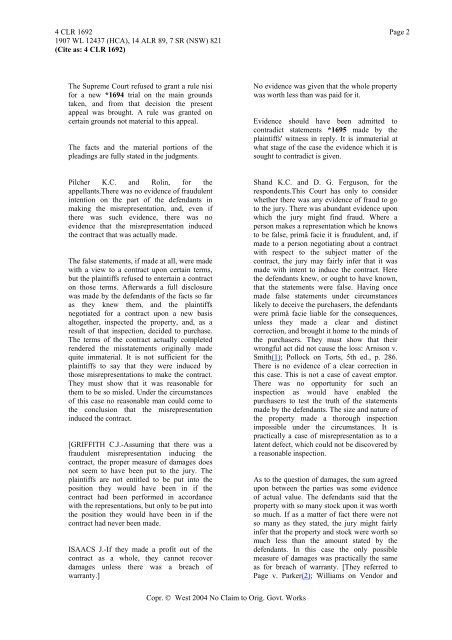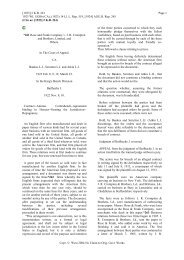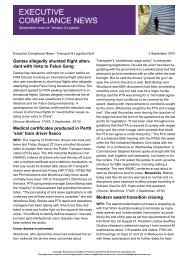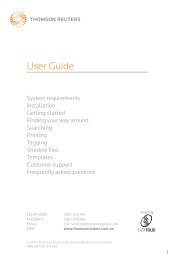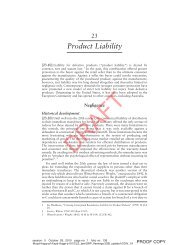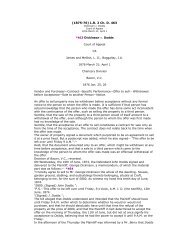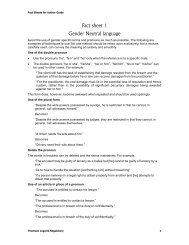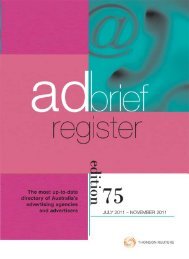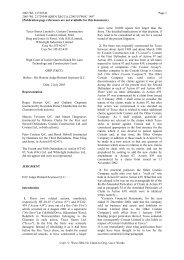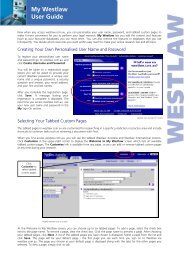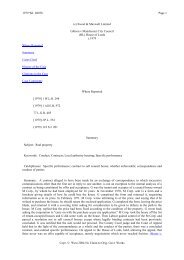Holmes v Jones - Thomson Reuters
Holmes v Jones - Thomson Reuters
Holmes v Jones - Thomson Reuters
- No tags were found...
You also want an ePaper? Increase the reach of your titles
YUMPU automatically turns print PDFs into web optimized ePapers that Google loves.
4 CLR 1692 Page 21907 WL 12437 (HCA), 14 ALR 89, 7 SR (NSW) 821(Cite as: 4 CLR 1692)The Supreme Court refused to grant a rule nisifor a new *1694 trial on the main groundstaken, and from that decision the presentappeal was brought. A rule was granted oncertain grounds not material to this appeal.The facts and the material portions of thepleadings are fully stated in the judgments.No evidence was given that the whole propertywas worth less than was paid for it.Evidence should have been admitted tocontradict statements *1695 made by theplaintiffs' witness in reply. It is immaterial atwhat stage of the case the evidence which it issought to contradict is given.Pilcher K.C. and Rolin, for theappellants.There was no evidence of fraudulentintention on the part of the defendants inmaking the misrepresentation, and, even ifthere was such evidence, there was noevidence that the misrepresentation inducedthe contract that was actually made.The false statements, if made at all, were madewith a view to a contract upon certain terms,but the plaintiffs refused to entertain a contracton those terms. Afterwards a full disclosurewas made by the defendants of the facts so faras they knew them, and the plaintiffsnegotiated for a contract upon a new basisaltogether, inspected the property, and, as aresult of that inspection, decided to purchase.The terms of the contract actually completedrendered the misstatements originally madequite immaterial. It is not sufficient for theplaintiffs to say that they were induced bythose misrepresentations to make the contract.They must show that it was reasonable forthem to be so misled. Under the circumstancesof this case no reasonable man could come tothe conclusion that the misrepresentationinduced the contract.[GRIFFITH C.J.-Assuming that there was afraudulent misrepresentation inducing thecontract, the proper measure of damages doesnot seem to have been put to the jury. Theplaintiffs are not entitled to be put into theposition they would have been in if thecontract had been performed in accordancewith the representations, but only to be put intothe position they would have been in if thecontract had never been made.ISAACS J.-If they made a profit out of thecontract as a whole, they cannot recoverdamages unless there was a breach ofwarranty.]Shand K.C. and D. G. Ferguson, for therespondents.This Court has only to considerwhether there was any evidence of fraud to goto the jury. There was abundant evidence uponwhich the jury might find fraud. Where aperson makes a representation which he knowsto be false, primâ facie it is fraudulent, and, ifmade to a person negotiating about a contractwith respect to the subject matter of thecontract, the jury may fairly infer that it wasmade with intent to induce the contract. Herethe defendants knew, or ought to have known,that the statements were false. Having oncemade false statements under circumstanceslikely to deceive the purchasers, the defendantswere primâ facie liable for the consequences,unless they made a clear and distinctcorrection, and brought it home to the minds ofthe purchasers. They must show that theirwrongful act did not cause the loss: Arnison v.Smith(1); Pollock on Torts, 5th ed., p. 286.There is no evidence of a clear correction inthis case. This is not a case of caveat emptor.There was no opportunity for such aninspection as would have enabled thepurchasers to test the truth of the statementsmade by the defendants. The size and nature ofthe property made a thorough inspectionimpossible under the circumstances. It ispractically a case of misrepresentation as to alatent defect, which could not be discovered bya reasonable inspection.As to the question of damages, the sum agreedupon between the parties was some evidenceof actual value. The defendants said that theproperty with so many stock upon it was worthso much. If as a matter of fact there were notso many as they stated, the jury might fairlyinfer that the property and stock were worth somuch less than the amount stated by thedefendants. In this case the only possiblemeasure of damages was practically the sameas for breach of warranty. [They referred toPage v. Parker(2); Williams on Vendor andCopr. © West 2004 No Claim to Orig. Govt. Works


